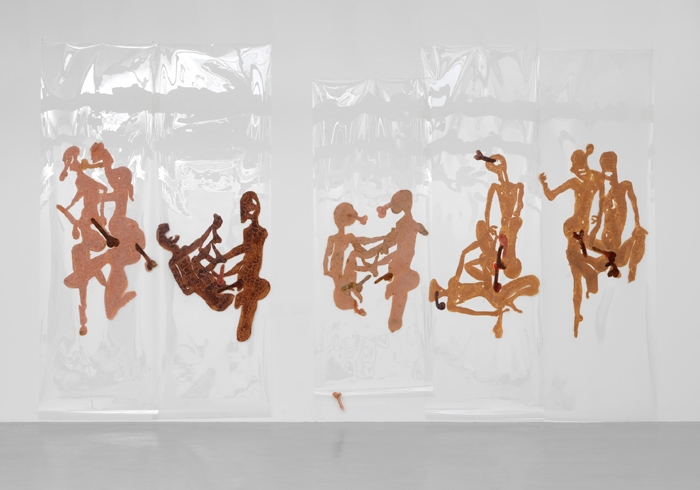While Roger Hiorns’s exhibition is on show at London’s Corvi-Mora (through 28 July), ArtReview revisits J.J. Charlesworth’s interview with the artist, first published in its Summer 2016 issue. Hiorns discusses his (now completed) public site project for Bristol, The Retrospective View of the Pathway, and the complicated business of burying passenger jets…
ArtReview Your new public sculpture, The retrospective view of the pathway, commissioned by Art and the Public Realm Bristol, is quite a challenging work for a city to commission.
Roger Hiorns That’s true. This hasn’t happened straightforwardly. It’s a provocative, monumental work in a very conservative area. The factors of the work are very much based on the circumstances of the time of its making, within the timeframe of a very precarious social and economic reality – one that continues. So, how to behave? What is the identity of an artwork that seeks not to offer a platitude to an indifferent public? To not again be the ‘Marie Antoinette’ commission? Essentially, it was an open brief, a budget based on a legal stipulation that an artwork must be made [as part of the planning permission for a mixed-use architectural development on Bristol’s floating harbour]. A developer in receivership after the crash, and the ‘will and testament’ of the whole project under the guidance of PricewaterhouseCoopers – a sort of demi-government – and an insurance company. The architect Stephen Witherford is the last key to this work. And all these ingredients, these incomplete and complete conversations, led to the making of this type of work and what it looks like. It’s a social document and hectoring neighbour…
AR It’s not so much a piece of sculpture as a public edifice with a potential function…
RH It’s a piece of municipal architecture that was once called the ‘free tank’ – the free tank was a space, a ‘nook’ in the built-up bank of the river that allowed ordinary people access to its water. As it turns out, it’s one of the only spaces that Bristol City Council retains as a piece of public land. The surrounding area is identikit, postmodernist shiny surfaces of indistinct and instant architecture. I wanted to go against the lightness and the shallowness of those surroundings by introducing heavy concretes and black granites. It became about wanting to overincrease the density and overdo the balance of the area somehow. I wanted to introduce two forms that we can loosely call ‘furnaces’.
But further to the inevitable object-making of sculpture, I wanted to change the laws that operate and maintain the space. I wanted to change the permissible activities within a space that seems so self-defined. So I thought it was interesting to talk to a nearby law firm about whether or not we could revise certain laws about permissible activities within this small area that aren’t usually allowed within this historically public space surrounded by privately owned space.
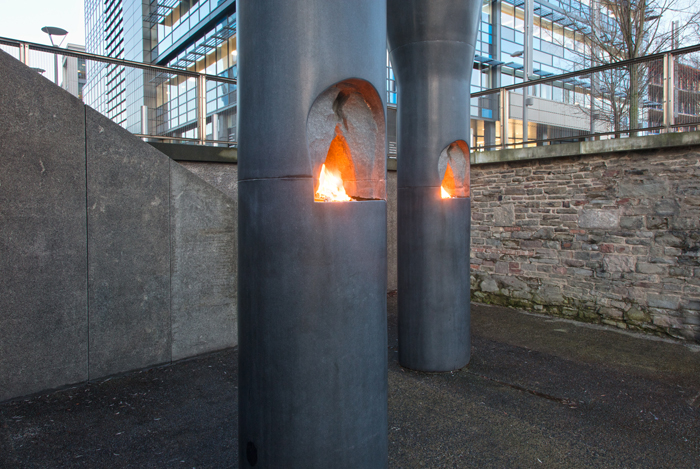
AR What was the outcome?
RH An absolute blank. Thoughts about how to present the body, put the human at the centre of the work for once, sadly were given little time. Ideas about public sexual identity, nudity… We didn’t get so far.
AR These furnaces, they’re functional?
RH There are two phallic chimneys made out of solid black granite, and then mounted into them as furnace mouths are two vulva openings. The forms are very simple and organic, but unusually monumental. They are about seven metres tall, transcendent in scale. They’re rare in their sophistication, and I wanted to encourage a scale that hadn’t been allowed or required from sculpture for a long time. And I wanted to offer an aesthetic timelessness, as if these were primary forms made by an earlier civilisation that wanted to celebrate a new god. Of course, I’m hypercritical about public art. It’s never a satisfying outcome, but sometimes one catches a work that transcends, an unexpected taste appears, usually by some accident, or by the intervention of an artist who was sophisticated enough to sidestep the usual expectation, to bridge that loose authority that maybe the museum or the gallery might still just enviously guard and maintain, to place something of human value into the area of the real and the everyday.
AR But they work as furnaces?
RH They somehow propose that the law firm could burn their paperwork inside them. Of course this is a mild irritation to the law firm.
AR And that other people could use the furnaces?
RH I can’t see why not, perhaps anyone can bring whatever they want to burn into this arena of stone and grey concrete. Of course, there will be prohibitions eventually put in place to stop this new idea, and I’m not even sure I disagree with that. The work proposes a loss of some public order that can’t really be sustainable for very long.
AR Are you expecting this work to be unloved?
RH I’m not expecting it to be entirely loved, no, but I do try to allow the work to be beautiful and transcendent, and this may be a challenge enough to the streamlined business and networking environment within which it rests.
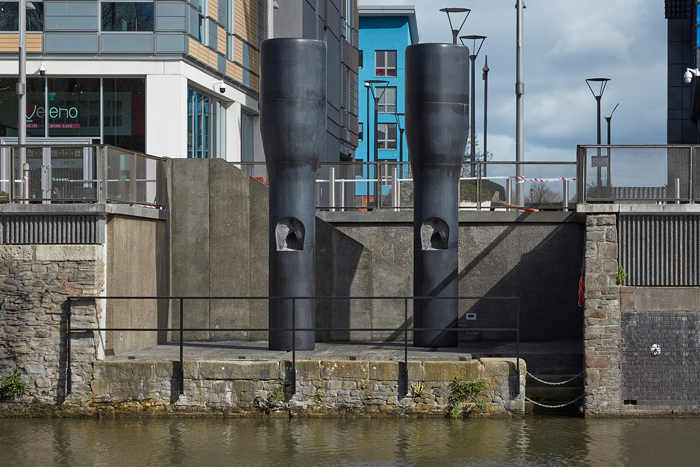
AR There are a lot of high-minded idealisms about what public art can achieve. This work doesn’t seem to want to entertain any of those…
RH There’s a well-meaning idea about how art might be used to bridge a gap between, for example, civil society and a minority group, or an extra-defined cohort in the north that feel underrepresented, so that a large sculpture of an angel defines that deficit in material terms. Is an artwork necessary or is a transition into another mode of public representation now necessary? The monumentality of the Bristol work was about achieving something that supports and elevates the human. A taking a stand on your being is in play; if you increase the proportions, if you increase the densities of things, other things will tear, the surrounding framework will break. That was always the case with my work, that at some point there will be a resistance to individual freedom, and a breakage is then necessary.
AR I’m curious about how you bring ritual into your work and how it has something to say about secular life, which is also part of this ambiguity we have about everyday modern, rationalistic life. It exists under the sign of secular society; there’s no more deity, there’s no more afterlife, there is only the business of getting on with living in a modern and technological world, in a material, human body. So when you’ve brought in ritual, it’s under the sign not of religion but of something that at its bare essential was the antithesis of secular life. You’re currently working on a performance for Birmingham Cathedral in June…
RH Well this is fascinating, because this then becomes about authority. The reason why I’m interested in this is that I’m not using the obvious materials of plastic and performance.
AR You’re using the choristers of Birmingham Cathedral – as a ‘material’?
RH Yes, I’m using religion and sermon and Evensong. Two Evensongs, Wednesday and Friday. The full choir – these children and the adult choir – will be essentially scattered, lying flat on their back, dispersed, atomised through the cathedral. They will be unarranged. They will be singing in the same fashion that they would be if they were as a choir but occupying the cathedral in a way that has not happened before. It’s a simple work that uses the medieval Evensong as a starting point. Again, a longestablished foundation stone of ritual in our society is revisited, grown upon, perverted.
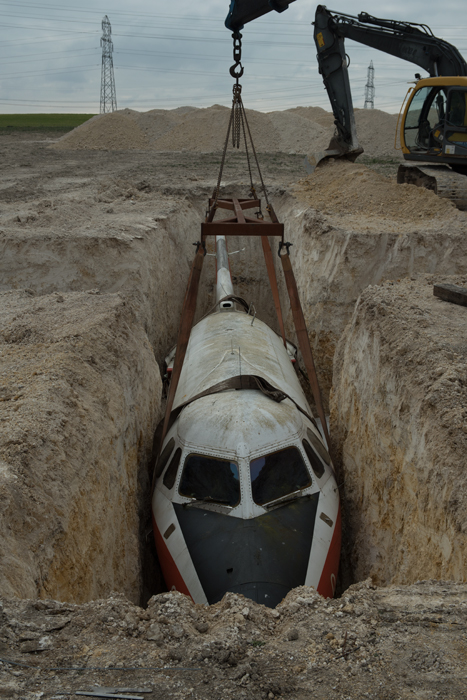
AR What’s troubling and interesting about a lot of what you have done is that the idea of activity and energy is somehow at stake. The idea of inertia becomes a big deal. Seizure (2008), for example, took a living space – a derelict council flat – and coated it with blue crystals, grown by filling the flat with copper sulphate solution. An inorganic process. The project you’re working on for Ikon in Birmingham for the next year is to bury a Boeing 737 and install a passage from the surface down directly into the passenger cabin of the plane…
RH A global network of buried planes is an ambitious plan. It’s interesting with the aeroplane, because I think that it is almost like the layering of clichés: it’s an incredibly literal work. There is something that I found really fascinating in pushing that literalness and continuing to push it to see what would happen.
So we take the idea of a burial, and we take the idea of a piece of global technology, an aeroplane, and we put it under the ground. Then we allow the individual to become a part of this equation too. It’s already an overwhelming proposition. As an artwork, it’s allowing a generosity that is perhaps unusual; it allows for the displacement of the artist, and in my place comes the viewer.
This work is not about me. I don’t paint, I’m not somebody who is following a tradition of technique. I’m following a tradition of manipulation. I’m also thinking about the self, the person who wants to be involved, to be in the work of art, because they are the conclusive part of the work. It was a very similar situation with Seizure: the human was the conclusive part of the work – the reaction of the human within the work was a factor in the completion of the work. There was often a personal significance for the visitor to the environment that I couldn’t access. There were people who wanted to have sex in Seizure, or you would have a prayer group who would join hands and start praying – there was a level of human activity not usually encouraged to emerge in a work of art, and so this all seemed new and essential and real. Back to the plane: I thought about the ramping up of anxieties, the ramping up of tensions, the claustrophobia of the aircraft, the symbolism of the craft, the fact that it’s buried, the fact that you’ll be funnelled into this thing under the ground…
When I think about the work and when I make the work in the studio, I’m thinking about a time in the future rather than a time in the present, where a more successful or more interesting or more dynamic language would occur that actually might be able to retranslate the rather flat present day into another dimensional vision. So if we anticipate the next future, if we anticipate the next language, it comes with the idea of the neurological more than anything. It’s about the understanding in the brain. If we understand the brain and its working.
AR The attention to ritual in many of your works that include and require participation in some ways suggests the control and regulation of experience by certain forms of administration and power. How does that intimate a future, if at all?
RH Well, the language of the future is a disestablishment language, a language actively disentangling the established codes of the present. We need a new language that focuses on our natural ability to deconstruct and neutralise threats. Together we can grind off the edges of our hardened experience of the world. Over the last 15 years we have invited ourselves into a situation that is not a fair representation of real freedom. Our current version of liberalism, neoliberalism if you like, is not a project for the elevation of all humans, and for humans to feel the eventual possibility of emancipation, to become a valued being in the world. So we have established authorities offering us a ‘capped’ freedom, a governing class who think a society where every human is sufficiently free and with an endless possibility of self-determination would represent a society that’s difficult to manage, difficult to trust to behave. It’s important not to be a manageable human, a good contemporary definition of an artist.
AR So again, ritual comes up as a spectre of…
RH …control
AR Or a caricature of a problem that’s not properly acknowledged in our current culture, which is the proposed notion of individual liberty, but the anxiety that liberty needs some…
RH …conditions. So these conditions have to be inherent within the work, because in a way they have to offer the container. As an artist, you don’t want to just make the objects, you want to make the context. An artwork can’t survive on its own. So you have to do some work to alleviate the pressures that will add to the demise of the new work, so it survives into the future… You have to contain the world, distil its primary contents, to allow the work to survive in its own novel language. An artist isn’t only designing or making artworks. An artist is more importantly allowing or establishing new versions of behaviour, new worlds.
These works are an amalgamation that allows a greater work to occur. It’s important to say that these works propose moods and feelings rather than ideas. So when we talk about mood, it’s a focusing on a level of contemporary dread and anxiety, which are not entirely wonderful things to bring into the palette of what we’re trying to do with contemporary art at the moment, but useful motivations towards an absence…
AR An absence of…?
RH Well, an absence of the human. I think the human hasn’t been put at the centre of art for a long time. I think that to some degree the callous shininess that is the contemporary artworld is almost designed as an exclusion of the human. I think that maybe it’s interesting to be contrarian to the established root that seems to occupy people’s minds. This economic preoccupation within the artworld, where things are shiny and callous, is probably a reflection of the new type of collector, and the texture of their limited attention span.
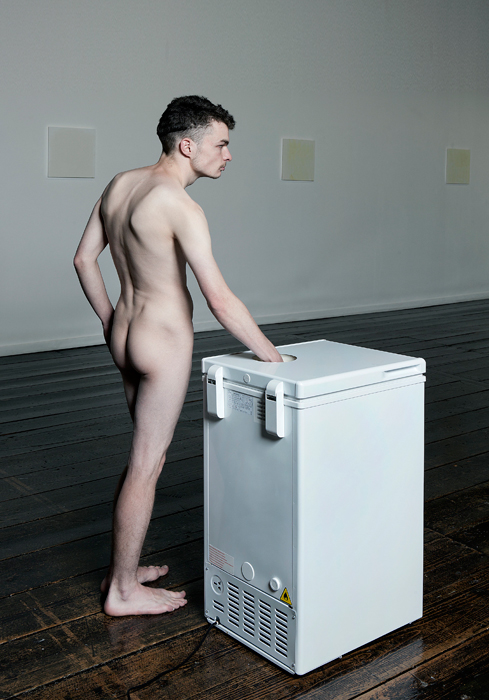
AR I wanted to discuss your contribution to the artist-curated show History Is Now, at the Hayward Gallery last year, a decade-by-decade picture of Britain in the postwar period. Unlike the other sections, which treated their decade through the history of artworks, you took a different approach: an informational presentation on an issue that had very little to do with contemporary art – the history of the ‘Mad Cow Disease’ epidemic, which took hold in the late 1980s and became a big political issue in the mid-90s, because of the fear that it might spread from cattle to humans (as variant Creutzfeldt Jakob Disease, or ‘variant CJD’). It was a quite a bold gesture within the usual habits of museum and art-gallery presentation.
RH The presentation of documentation and a timeline of archive material was the most important aspect, and yes, it was blunt, and tough to experience. In making the variant CJD show, I think it was really the pathology of variant CJD that fascinated me most: this story of the prion (a misshaped protein), the way that it can readapt brain matter in a human body to replicate itself and thus to disassemble the brain, turn it into a spongelike material – an agent of fundamental physical and mental destruction.
Again, actually to talk about mood, in terms of the allowance of dread as a translator within an art frame. We’re in this constant state of self-denial and delusion. The artworld seems to be a road map of delusion right now, and I think it seems to be worth considering the breakup of this delusional unreality by dropping in an increased amount of reality.
The fact that the variant CJD material presents itself as an artwork allows it a certain type of status, and that status allows it a unique and enduring position in the world. The artworld context allows the subject matter to become active again. It’s as viable an artwork as a Richard Long stone circle, and somehow it operates on the terms of an established art-history, but what is radical about the work is that it collects and represents and then displays power and the operation of power against the human. The CJD section of History Is Now displayed a tapestry of aggressive will against the human on an unprecedented scale, and the repercussions are only now being understood. The work provoked a reaction, a pushback, bringing the story back to the public realm, delivered to our future selves. Most of the time this never happens, we are awash with artworks that are passive, studio-made, salon-hung, clerks to a regime of material wealth and cynical boredom.
This approach seems to me the future in my approach to making artworks: we can learn to use and reutilise the value that people still think is somehow present within art as a force to reinvigorate human potential. Over the last ten years the fascination with the art market, with spectacle, with short-term thinking has effectively closed down this long-constructed, uniquely liberal and international space for progressive thinking to occur and be enacted upon.
AR Seems to be that you’re pointing to the idea that art does have some use, but it’s just not what we think it is any more.
RH Perhaps we’re seeing the last market artworks being made, or performed. I think the journey towards the last artwork is a fascinating problem for me, or anyone, to consider.
From the Summer 2016 issue of ArtReview
